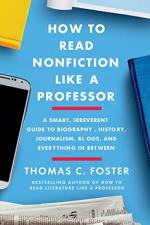
|
| Name: _________________________ | Period: ___________________ |
This quiz consists of 5 multiple choice and 5 short answer questions through Section 2: Chapter 5, "It May Just Be Me, But..." through Chapter 8, "Bringing the News".
Multiple Choice Questions
1. In Chapter 2, "The Ecology of the Nonfiction Biosphere," what does Foster say is the point of having a variety of media sources?
(a) Accuracy.
(b) Appealing to different readers.
(c) Time.
(d) Depth of coverage.
2. In Chapter 1, "The Structure of Nonfiction Information," what are the "four Ps" that Foster discusses?
(a) Purpose, paraphrase, platform, and paragraph.
(b) Problem, promise, program, and platform.
(c) Purpose, proposal, program, and plan.
(d) Problem, proposal, program, and plan.
3. In Chapter 6, "Source Code," which is the only type of nonfiction that Foster says doesn't need "rock-solid" sources (69)?
(a) Memoir.
(b) Reportage.
(c) Biography.
(d) Philosophy.
4. In Chapter 6, "Source Code," where does Foster suggest writers should gather information about historical figures?
(a) Primary sources.
(b) Biographies.
(c) History books.
(d) Newspaper archives.
5. The section of this book called "What's Going on Around Here?" is what part of the book?
(a) A preface.
(b) An appendix.
(c) A foreward.
(d) The introduction.
Short Answer Questions
1. In Chapter 8, "Bringing the News," Foster describes the Larry Nassar scandal as an illustration of what?
2. In Chapter 7, "All in How You Look at Things," Whome does Foster say is "our greatest living thinker about writing nonfiction" (81)?
3. In Chapter 7, "All in How You Look at Things," Foster tells us that changing the structure of a story changes its what?
4. In Chapter 3, "The Power of the Prologue," what does Foster say distinguishes the prologue from a preface?
5. In Chapter 5, "It May Just Be Me, But..." what kind of person does Foster say is likely to be biased?
|
This section contains 312 words (approx. 2 pages at 300 words per page) |

|




